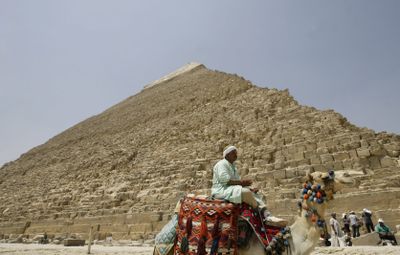Egypt upgrading security, ambience at Giza Pyramids

CAIRO, Egypt – Tourists have long been awed by Egypt’s famed Giza Pyramids and irritated by having to fend off peddlers relentlessly offering camel rides and trinkets.
But the hustlers were gone Monday as Egypt started an elaborate project to modernize the area and make it friendlier to tourists. Security is also improving, with a 12-mile chain-link fence featuring cameras, alarms and motion detectors.
“It was a zoo,” said Zahi Hawass, Egypt’s chief archaeologist, recalling the past free-for-all. “Now we are protecting both the tourists and the ancient monuments.”
The three Giza Pyramids have been unusually open for a 5,000-year-old Wonder of the World.
The desert plateau on which they stand was once isolated. But as the capital has expanded, slums have been built right to the edge of the site, separated in places by only a low stone wall. The rest of the area has been wide open to the desert.
Tourists undergo a constant barrage from peddlers selling souvenir statues, T-shirts and other trinkets. Visitors are sometimes followed by men on camels selling rides or photos – and rarely taking no for an answer.
But tourists have taken their own liberties. Climbing the Pyramid of Khufu, the biggest of the three monuments, was a favorite challenge for visitors beginning in the 19th century and continuing into the 1970s, despite the occasional fatal fall of an inebriated tourist.
Since then, authorities have cracked down on climbing the giant 2.5-ton blocks, though visitors can still ramble freely around the pyramid grounds, where many tombs and other archaeological sites remain only partially excavated and vulnerable to damage.
Security concerns were highlighted in 1997, when Islamic militant gunmen attacked tourists at a desert temple in the southern city of Luxor, killing more than 60.
The new technology aims to curb shenanigans by both tourists and peddlers.
The long chain-link fence around the plateau reaches a height of 13 feet at some points, and it is dotted with infrared sensors and motion detectors that set off alarms at a control room on the plateau.
“Intruders can’t jump over this,” said Kamal Wahid, the site’s general director.
Tourists enter through a new brick entrance building, with half a dozen gates equipped with metal detectors and X-ray machines. Once inside, their every step is closely watched by 199 closed-circuit cameras covering every corner of the sprawling plateau.
As Hawass and antiquity authorities showed off the changes Monday, trinket sellers were nowhere to be seen, apparently ordered off the plateau. Three lone camel riders in male Arab headscarf and the traditional galabeyah robes were standing at the edge of the plateau.
It was not clear whether the trinket dealers were pushed out just for the day or whether they would return in a more controlled fashion. Wahid said phasing out the hawkers will not be sudden or “unkind.”
“Two years from now, you won’t see them inside the site,” he said, adding that an area nearby will be designated for horse and camel rides.
The changes are part of a $26 million improvement project that began seven years ago, Hawass said. Still to come are a new lighting system, a cafeteria, and a visitors center and book shop.